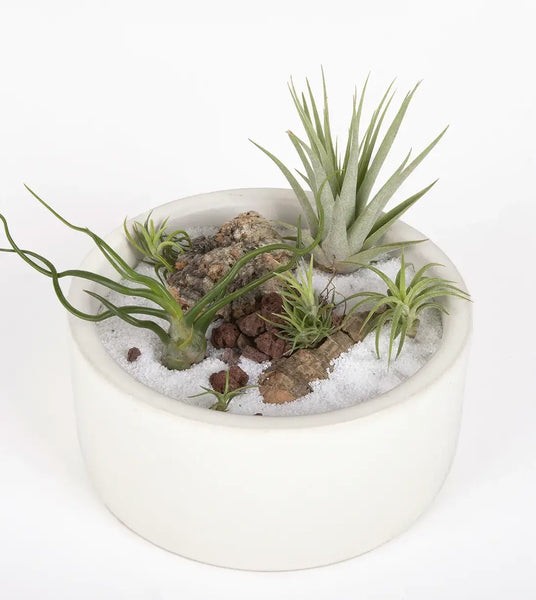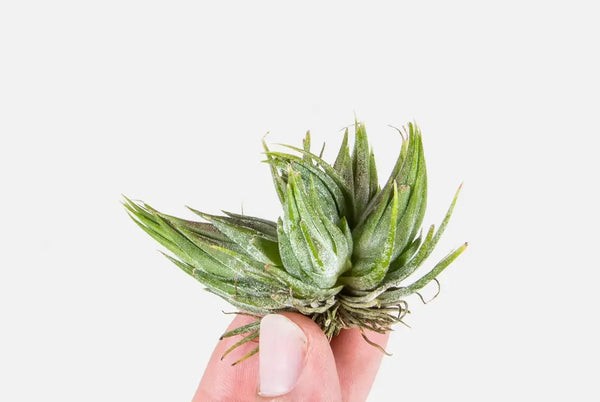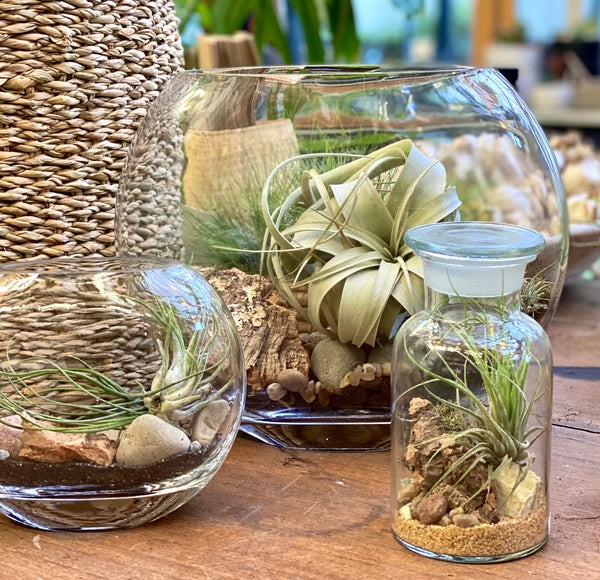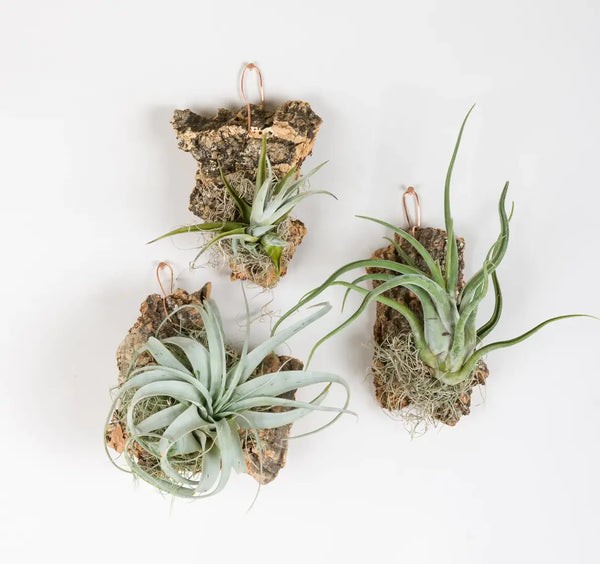Caring for air plants, also known as Tillandsia, doesn’t require soil, making them a unique addition to your space. This guide from CARS.EDU.VN provides everything you need to know about air plant care, from lighting and watering to propagation. Explore the world of Tillandsia varieties, maintenance tips, and ensure your air plants thrive with optimal air circulation and humidity levels.
1. Understanding Air Plants: More Than Just Air
Air plants, scientifically known as Tillandsia, are epiphytes, meaning they grow on other plants or objects without harming them. They absorb nutrients and moisture from the air, not from soil. Thriving on bright, indirect light, air plants can be watered by misting or soaking, depending on the environment. This makes them versatile décor, perfect for terrariums, mounts, or standalone displays. With proper care, your air plant will flourish, adding a touch of greenery to any space.
2. Optimizing Light for Your Air Plant
2.1. The Ideal Light Conditions
To thrive, air plants require bright, indirect light, mimicking their natural habitat. South- or east-facing windows are ideal, offering ample sunlight throughout the day. North-facing windows work too, provided the plant is close to the glass. Western light can be intense, so monitor your plant for scorching.
As a rule, higher humidity allows air plants to tolerate more light. In sunny locations, increase misting to twice weekly or even daily. Bathrooms or kitchens are great, where humidity from showers or cooking naturally moistens the plant.
2.2. Air Plants and Artificial Illumination
For offices or basements with no natural light, full-spectrum fluorescent lights are essential. Incandescent bulbs don’t provide sufficient light for photosynthesis. Place Tillandsia within 3 feet of the light source and provide at least 12 hours of light per day.
For consistent light, consider a specialized bulb like Gro-Lux, Repta-Sun, or Vita-Lite on a 12-hour timer. This ensures your plant receives the necessary light to survive, regardless of natural conditions.
A shallow dish filled with sand, rocks, and dried wood offers a charming way to showcase your air plants.
3. The Art of Watering Air Plants
3.1. Mastering the Watering Techniques
Watering is critical, yet the trickiest aspect of air plant care. Some prefer misting, others soaking, or a combination. The plant’s needs vary based on its environment.
Begin by assessing your space: How much light does the plant get? What’s the temperature? Is the air dry (near a heater) or humid? Adjust watering to suit these conditions. As a starting point, here’s what we recommend:
- Every one to two weeks, soak your air plant in room temperature tap water for 5-10 minutes.
- Gently shake off excess water after soaking.
- Place the plant upside down on a towel in a bright spot to dry.
- The plant should dry within 3 hours to prevent rot. Increase air circulation for faster drying.
- Mist the plant thoroughly once a week, ensuring the entire surface is moist.
- Water more frequently in hot, dry conditions (summer) and less in cool, humid conditions (winter).
- Always water in the morning to allow the plant to dry during the day.
3.2. Recognizing the Signs of Hydration
Under-watering signs include brown or crispy leaf tips and an exaggerated concave leaf shape. Unfortunately, over-watering is often fatal. A brown or black base with leaves falling off indicates rot.
Air plants thrive in temperatures between 50-90 degrees F, with cooler overnight temperatures. Fertilize with orchid or air plant fertilizer once or twice a month to encourage blooming and reproduction. A pinch in the water is sufficient.
3.3. Air Plant Misting Guide
Misting air plants is a great way to keep them hydrated between soakings, especially in drier environments. Here’s a simple guide to ensure you’re misting correctly:
- Frequency: Mist your air plants 1-2 times per week, or more often if the air is particularly dry.
- Technique: Use a spray bottle to thoroughly mist the entire plant until it’s visibly damp.
- Timing: Mist in the morning to allow the plant to dry out during the day, preventing rot.
- Environment: Adjust misting frequency based on the humidity of your environment; less in humid conditions, more in dry conditions.
- Water Quality: Use room temperature tap water or rainwater for misting.
- Observation: Monitor your plant for signs of dehydration (crispy leaves) or overhydration (rot) and adjust accordingly.
3.4. Air Plant Soaking Guide
Soaking is an effective method to hydrate air plants, ensuring they receive enough moisture. Follow these steps for a successful soak:
- Frequency: Soak your air plants every 1-2 weeks, depending on the dryness of your environment.
- Preparation: Fill a bowl with room temperature tap water or rainwater.
- Submerge: Fully submerge your air plant in the water for 5-10 minutes.
- Removal: Remove the plant and gently shake off any excess water.
- Drying: Place the plant upside down on a towel in a well-lit area to dry completely within a few hours.
- Observation: Look for signs of dehydration or overhydration and adjust the soaking frequency as needed.
4. Understanding the Air Plant Life Cycle
4.1. Blooming and Reproduction
Air plants flower only once, with blossoms lasting from days to months in various bright colors like pink, red, and purple. Flowering marks the plant’s peak but also the beginning of its decline.
However, before, during, or after flowering, the plant reproduces by sending out 2-8 “pups”. These baby air plants grow into their own, eventually becoming mother plants. Pups can be separated when they’re about ⅓-½ the size of the original plant, ensuring they receive sufficient nutrients from the mother plant.
Tillandsia boast some of the most vibrant blooms in the plant kingdom.
4.2. Propagating Air Plants
Propagating air plants is a rewarding process that allows you to expand your collection. Here’s how to do it:
- Wait for Pups: Air plants naturally produce “pups” or offshoots, especially after flowering.
- Separation: Once the pup is about ⅓ to ½ the size of the mother plant, it can be safely separated.
- Gentle Removal: Carefully twist or cut the pup away from the mother plant, ensuring minimal damage.
- Independent Care: Treat the pup as you would a mature air plant, providing adequate light, water, and air circulation.
- Continued Growth: Watch your new air plant thrive and eventually produce its own pups, continuing the cycle.
Tillandsia reproduce by forming “pups” which create a cluster over time.
5. Caring for Air Plants in Aeriums and Terrariums
5.1. Managing Air Plants in Glass Containers
Smaller air plants are perfect for terrariums, also known as aeriums. Caring for them in glass requires a few adaptations:
- If you can remove the plant: Follow the general care regimen, removing the plant to mist or soak, and allowing it to dry before returning it to the glass.
- Glass creates a micro-climate: Glass vessels are more humid and hotter than the surrounding area. Avoid placing them too close to a window to prevent burning.
- If you cannot remove the plant: Rely on misting since soaking isn’t possible. Less air circulation means less frequent misting. Larger glass means more air circulation and more frequent misting. Mist around the plant to create humidity without over-watering. Start with weekly misting and adjust as needed.
5.2. Maximizing Air Circulation
Ensuring proper air circulation is vital for air plants in terrariums. Follow these tips:
- Open Terrariums: Opt for terrariums with openings to allow air to flow freely.
- Avoid Overcrowding: Ensure plants aren’t packed too tightly, which can restrict air movement.
- Regular Airing: Periodically remove the lid of closed terrariums to allow fresh air to circulate.
- Strategic Placement: Position terrariums in areas with gentle air movement but away from direct drafts.
- Monitor Humidity: Keep an eye on humidity levels to prevent excessive moisture buildup, which can hinder air circulation.
If you can remove your air plant from its glass container:
Aerium displays are an ideal way to cultivate air plants, enhancing their appeal while simplifying maintenance.
5.3. Choosing the Right Terrarium
Selecting the right terrarium for your air plants is essential for their health and aesthetic appeal. Consider these factors:
- Material: Glass terrariums are ideal as they allow ample light penetration.
- Size: Choose a size that accommodates your air plants without overcrowding, ensuring good air circulation.
- Shape: Open terrariums or those with ventilation are preferable to prevent excessive humidity buildup.
- Design: Select a design that complements your décor and provides a stable base for your plants.
- Accessibility: Opt for terrariums that are easy to access for watering and maintenance.
6. Caring for Mounted Air Plants
6.1. Keeping Mounted Air Plants Healthy
Mounted air plants, like those in small glass vessels, cannot be soaked. They need frequent misting, starting with twice weekly and adjusting based on drying time.
6.2. Selecting the Right Mount
Choosing the right mount is crucial for showcasing your air plants and ensuring their health. Here’s what to consider:
- Material: Opt for natural, non-toxic materials like wood, cork bark, or stone that won’t harm the plant.
- Texture: Select a mount with a rough surface to provide a good grip for the air plant’s roots.
- Size: Ensure the mount is appropriately sized to accommodate the air plant without overcrowding.
- Aesthetics: Choose a mount that complements the plant’s appearance and your overall décor.
- Durability: Select a sturdy mount that can withstand regular misting and handling.
With adherence to these air plant care guidelines, your Tillandsia should thrive, offering beauty and vibrancy to your space.
7. Advanced Air Plant Care
7.1. Fertilizing Your Air Plants
Fertilizing your air plants can promote healthier growth and vibrant blooms. Here’s how to do it effectively:
- Type of Fertilizer: Use a bromeliad or air plant-specific fertilizer diluted to about ¼ strength.
- Frequency: Fertilize every 2-4 weeks during the growing season (spring and summer).
- Application: Add the diluted fertilizer to your misting or soaking water.
- Even Distribution: Ensure the fertilizer solution reaches all parts of the plant for even nutrient absorption.
- Rinsing: After fertilizing, rinse the plant with plain water to prevent salt buildup.
7.2. Dealing with Common Air Plant Problems
Even with the best care, air plants can encounter problems. Here are solutions for common issues:
- Rot: Prevent rot by ensuring plants dry quickly after watering. Remove any affected parts immediately.
- Dehydration: Increase misting or soaking frequency if leaves appear shriveled or dry.
- Pests: Treat infestations with a mild insecticidal soap, ensuring thorough coverage.
- Sunburn: Move plants away from direct sunlight to prevent scorched leaves.
- Nutrient Deficiency: Fertilize regularly during the growing season to address nutrient deficiencies.
7.3. Seasonal Air Plant Care
Adjusting your air plant care routine seasonally ensures they thrive year-round:
| Season | Care Adjustment |
|---|---|
| Spring | Increase watering and fertilizing as plants enter their growing season. |
| Summer | Provide shade during intense sunlight and ensure good air circulation. |
| Fall | Reduce watering frequency as growth slows down. |
| Winter | Provide extra light if needed and avoid placing near heaters. |





7.4. Common Air Plant Species
| Species Name | Description |
|---|---|
| Tillandsia Xerographica | Known for its curly leaves and large size. |
| Tillandsia Ionantha | Small and colorful, turning red when blooming. |
| Tillandsia Bulbosa | Resembles an octopus with bulbous base and curly leaves. |
| Tillandsia Capitata | Forms a dense rosette and turns vibrant colors when flowering. |
| Tillandsia Aeranthos | Easy to care for and produces beautiful purple flowers. |
| Tillandsia Brachycaulos | Known for its dramatic color changes, especially when blooming. |
| Tillandsia Stricta | Features soft, silvery leaves and produces pink or purple flowers. |
| Tillandsia Usneoides (Spanish Moss) | Long, stringy plant often used in decorative displays. |
| Tillandsia Cyanea | Unique for its paddle-shaped pink flower spike. |
| Tillandsia Argentea | Small, spiky plant with silvery leaves. |
8. Finding Quality Air Plants and Accessories
8.1. Where to Buy Air Plants
Finding healthy air plants is essential for a thriving collection. Consider these options:
- Local Nurseries: Visit local nurseries for a hands-on selection and expert advice.
- Online Retailers: Explore reputable online retailers for a wide variety of species and convenient delivery.
- Specialty Shops: Check out specialty plant shops for unique and rare air plant varieties.
- Farmers Markets: Browse farmers markets for locally grown air plants and accessories.
- Plant Swaps: Participate in plant swaps to exchange plants with other enthusiasts.
8.2. Essential Accessories for Air Plants
Enhance your air plant care with these essential accessories:
- Spray Bottle: For misting plants to maintain humidity.
- Mounting Materials: Cork bark, wood, or stone for displaying air plants.
- Fertilizer: Bromeliad or air plant-specific fertilizer for healthy growth.
- Terrariums: Glass containers for creating decorative displays.
- Grow Lights: Full-spectrum lights for providing adequate illumination in low-light environments.
9. Integrating Air Plants into Your Décor
9.1. Creative Display Ideas
Air plants can be creatively displayed in various ways to enhance your home décor:
- Hanging Displays: Suspend air plants in glass globes or macramé hangers.
- Mounted Arrangements: Attach air plants to driftwood or cork bark for a natural look.
- Terrarium Centerpieces: Create stunning terrarium centerpieces with air plants, rocks, and moss.
- Vertical Gardens: Design vertical gardens with air plants mounted on panels or boards.
- Desk Accessories: Add small air plants to desk accessories like pen holders or decorative bowls.
9.2. Styling Tips for Air Plants
Follow these styling tips to make the most of your air plants:
- Groupings: Arrange air plants in clusters of varying sizes and shapes for visual interest.
- Color Coordination: Pair air plants with décor elements that complement their colors and textures.
- Natural Elements: Incorporate natural elements like stones, shells, and branches into your displays.
- Minimalist Approach: Embrace a minimalist approach by showcasing air plants in simple, elegant holders.
- Seasonal Themes: Update your displays with seasonal themes and decorations to keep them fresh and engaging.
10. Air Plant Care: Addressing Your Concerns
10.1. Common Air Plant Myths Debunked
Let’s clear up some common misconceptions about air plant care:
- Myth: Air plants only need air.
- Fact: Air plants need regular watering through misting or soaking.
- Myth: Air plants thrive in direct sunlight.
- Fact: Air plants prefer bright, indirect light and can burn in direct sunlight.
- Myth: Air plants don’t need fertilizer.
- Fact: Fertilizing promotes healthier growth and flowering.
- Myth: Air plants can’t rot.
- Fact: Overwatering can lead to rot, so proper drying is essential.
- Myth: All air plants are the same.
- Fact: Different air plant species have varying care requirements.
10.2. Air Plant Troubleshooting Guide
Use this troubleshooting guide to address common air plant issues:
| Problem | Cause | Solution |
|---|---|---|
| Yellowing Leaves | Overwatering or insufficient light | Adjust watering frequency and ensure adequate indirect light. |
| Brown Leaf Tips | Dehydration | Increase misting or soaking frequency. |
| Soft, Mushy Base | Rot due to overwatering | Remove affected parts and allow the plant to dry thoroughly. |
| Stunted Growth | Lack of nutrients | Fertilize regularly during the growing season. |
| Pest Infestation | Mealybugs or scale insects | Treat with insecticidal soap or neem oil. |
| Sunburned Leaves | Exposure to direct sunlight | Move the plant to a location with indirect light. |
| Wrinkled Leaves | Dehydration or low humidity | Increase misting frequency and consider using a humidifier. |
| No Flowering | Lack of nutrients or improper care | Fertilize regularly and ensure proper light and watering conditions. |
| Leggy Growth | Insufficient light | Move the plant to a brighter location or supplement with artificial light. |
| Leaf Drop | Stress due to sudden environmental changes | Maintain stable temperature and humidity levels. |
10.3. Expert Tips for Thriving Air Plants
Follow these expert tips to ensure your air plants flourish:
- Water Quality: Use filtered or rainwater to avoid mineral buildup.
- Air Circulation: Ensure good air circulation to prevent rot.
- Temperature: Maintain a temperature range between 50-90°F (10-32°C).
- Humidity: Keep humidity levels moderate to high.
- Inspection: Regularly inspect plants for pests or signs of disease.
10.4. Creating the Perfect Environment
To create the ideal environment for your air plants, consider these factors:
- Light: Provide bright, indirect light.
- Water: Water regularly through misting or soaking.
- Air Circulation: Ensure good airflow to prevent rot.
- Humidity: Maintain moderate to high humidity levels.
- Temperature: Keep a stable temperature range.
By following these guidelines, your air plants will thrive and add beauty to your living space.
Finding reliable information and services for your car can be challenging, but CARS.EDU.VN is here to help. Whether you need detailed maintenance guides, expert repair tips, or assistance in choosing the right vehicle, our comprehensive resources are designed to meet your needs. Don’t let car troubles slow you down. Visit cars.edu.vn today at our location: 456 Auto Drive, Anytown, CA 90210, United States. Contact us via WhatsApp at +1 555-123-4567, and let us help you keep your car running smoothly. We’re here to provide the support and expertise you need.
FAQ: Air Plant Care
- How often should I water my air plant?
- Water every 1-2 weeks by soaking for 5-10 minutes or misting thoroughly.
- What kind of light do air plants need?
- Bright, indirect light is ideal; avoid direct sunlight.
- Can I use tap water for my air plant?
- Yes, but filtered or rainwater is better to avoid mineral buildup.
- How do I know if my air plant is getting enough water?
- Healthy leaves are firm and green; dehydrated leaves are shriveled and dry.
- What causes air plant rot?
- Overwatering and poor air circulation.
- Do air plants need fertilizer?
- Yes, fertilize every 2-4 weeks during the growing season with a diluted bromeliad fertilizer.
- How do I propagate air plants?
- Wait for pups to grow to ⅓-½ the size of the mother plant, then gently separate them.
- Can air plants grow in terrariums?
- Yes, but ensure good air circulation and avoid excessive humidity.
- How long do air plants live?
- Air plants can live for several years with proper care.
- What are common signs of air plant stress?
- Yellowing leaves, brown leaf tips, and stunted growth.

